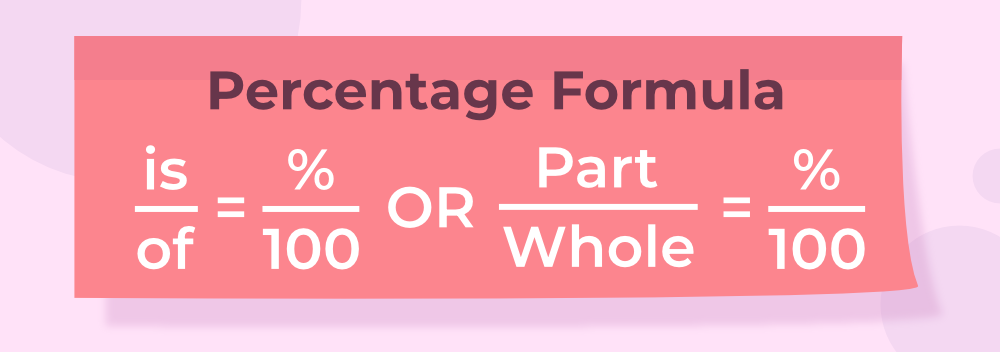Uses of Percentage in Daily Life
Last Updated :
01 Apr, 2024
Percentage is a mathematical concept that represents a fraction of a whole expressed as a hundredth. It is widely used in various aspects of our daily lives, from financial transactions to scientific measurements.
In this article, we will learn about, the definition of percentages, the application of percentages, and others in detail.
Percentage
Percentage is denoted by the symbol %, which means “per hundred.” It represents a fraction of a whole, where the whole is considered to be 100. For example, 50% means 50 parts out of 100, which is equivalent to the fraction 1/2. Percentage formula is added in the image added below:

A fraction whose denominator is 100 is called a Percent. Examples of fractions include, a student getting 84 marks out of 100 in an exam then he gets 84/100 × 100 = 84%
Applications of Percentage
Percentage has numerous applications in daily life, including:
In Finance and Accounting
Percentages are extensively used in finance and accounting for various purposes, such as calculating interest rates, profit margins, returns on investment, depreciation, taxes, and financial ratios.
In Sales and Marketing
Percentages are used in sales and marketing to calculate discounts, markups, sales growth rates, market shares, conversion rates, and other performance metrics.
In Economics
Percentages are used in economics to measure changes in prices, inflation rates, unemployment rates, GDP growth rates, interest rates, and other economic indicators.
In Statistics
Percentages are used in statistics to represent proportions, frequencies, probabilities, margins of error, confidence intervals, and other statistical measures.
In Education
Percentages are used in education to grade assignments, exams, and assessments, as well as to calculate graduation rates, attendance rates, and other educational metrics.
In Healthcare
Percentages are used in healthcare to calculate medical test results, mortality rates, disease prevalence, treatment success rates, and other healthcare statistics.
Real-Life Applications of Percentage
Some specific examples of how percentage is used in daily life are:
- Calculating Interest
- Getting a Discount
- Calculating Sales Tax
- Grading Assignments
Now let’s learn about the same in detail.
Calculating Interest
If you borrow $1000 at an interest rate of 5% per year, you will pay $50 in interest over the first year. This can be calculated as 5% × $1000 = $50. Thus, the use of percentage is used in calculating interest.
Getting a Discount
If a store offers a 20% discount on a $50 item, you will save $10. This can be calculated as 20% × $50 = $10. Thus, concept of percentage is used in calculating discount.
Calculating Sales Tax
When you purchase an item, you may be charged a sales tax, which is a percentage of the purchase price. For example, if the sales tax rate is 8%, and you purchase an item for $100, you will pay $8 in sales tax.
Grading Assignments
A teacher may grade an assignment out of 100 points. If a student earns 85 points, their grade can be expressed as 85%.
Conclusion
Percentage is a versatile mathematical concept that has numerous applications in daily life. Understanding the concept of percentage allows us to make informed decisions, solve problems, and navigate various situations effectively. By mastering the use of percentage, we can gain a deeper understanding of the world around us and make the most of our everyday experiences.
FAQs on Percentage
What are uses of percentages?
Some applications of percentage are:
- Percentage is used to compare numerical data and compare data by corporations, firms, governments, schools and colleges.
- Percentage is used by shopkeepers and companies to calculate the profit/loss percentage on the goods sold.
What is real life application of percentage change?
Percentage change is used to find out the profit or loss an item and others.
How to convert a fraction to a percentage?
To convert a fraction to a percentage, multiply the fraction by 100. For example, to convert 1/2 to a percentage, multiply 1/2 by 100, which gives you 50%.
How to convert a percentage to a decimal?
To convert a percentage to a decimal, divide the percentage by 100. For example, to convert 50% to a decimal, divide 50 by 100, which gives you 0.5.
What is difference between percentage and ratio?
A percentage is a fraction expressed as a hundredth, while a ratio is a comparison of two numbers. For example, 50% is equivalent to the ratio 1:2.
How to calculate percentage change?
To calculate the percentage change, subtract the original value from the new value, and then divide the difference by the original value. Multiply the result by 100 to express it as a percentage.
What is use of percentage in probability?
Percentage is used in probability to express the likelihood of an event occurring. For example, if there is a 50% chance of rain, it means that the event of rain occurring is equally likely to happen or not happen.
Share your thoughts in the comments
Please Login to comment...